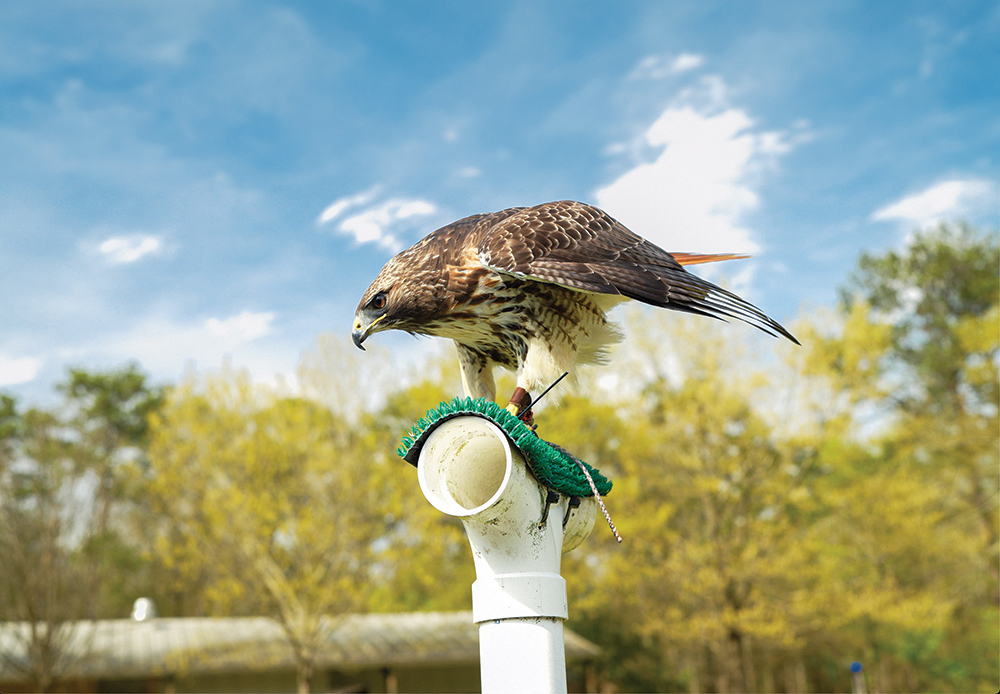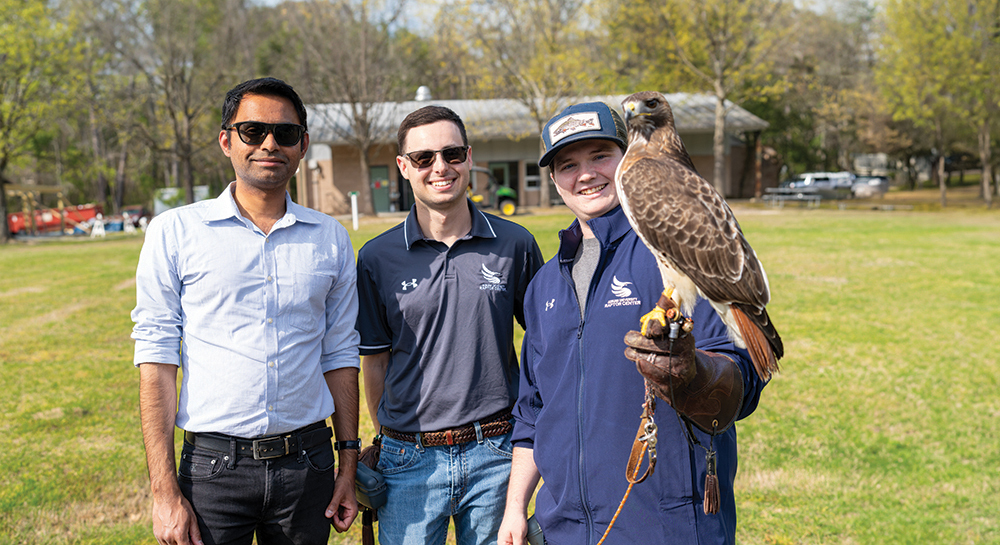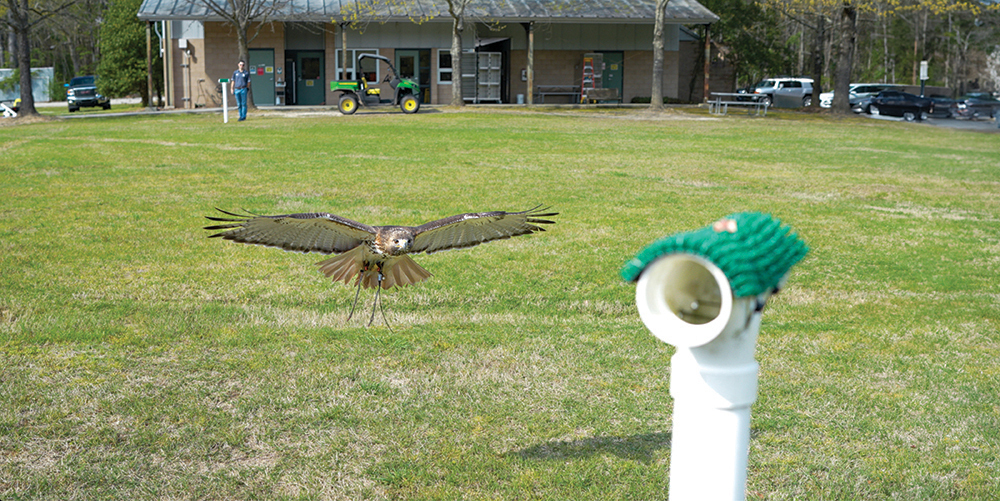
Aerospace engineering associate professor Vrishank Raghav let his curiosity run free while watching a pregame flight at Jordan-Hare Stadium. Now, he’s studying the flight patterns of birds to learn how they fly seamlessly despite changing weather patterns.
Vrishank Raghav was enjoying his first experience at Jordan-Hare Stadium on a fall afternoon in 2018 when Nova — also known as War Eagle VII — took his traditional pregame flight to the delight of more than 80,000 fans.
Raghav, who had just joined the Department of Aerospace Engineering as an assistant professor, was intrigued by Nova’s performance and how controlled it seemed while soaring through the air. After the game, he researched where Nova spent time when not rallying the Auburn Tigers to victory and learned of the Auburn University Raptor Center.
The Auburn University Raptor Center, a division of the College of Veterinary Medicine, is a rehabilitation and education facility providing critical education and conservation efforts for raptors.
Raghav and the Raptor Center soon formed a partnership. In 2018, he received funds from Auburn University’s Intramural Grants Program (IGP) to study a red-tailed hawk named Petey. The goal was to learn how birds can quickly adapt to adverse aerodynamic environments due to changing weather conditions — where traditional aircraft and unmanned aerial vehicles seem to struggle.
“You look around on a bad weather day, and most flights are grounded, and there are delays all around the country,” Raghav said. “But birds are still flying, and it appears that the bad weather doesn’t affect them. The big question for us researchers and engineers is how they have adapted to achieve smooth flight in adverse conditions.”
Wade Stevens, director of the Raptor Center, said studying nature’s reactions to turbulence or wind gusts is an interesting concept that makes a lot of sense.
“Birds are naturally adept at dealing with different factors they encounter in nature, especially when flying through harsh storms that ground most aircraft or cause delays,” Stevens said. “I think it’s a natural progression to say, ‘let’s figure out how they do this,’ and look for ways we can recreate all, or portions, of that.”
Raghav and his team set up a row of upward-facing fans to generate wind gusts for Petey to fly through to track how he adjusts his flight pattern to compensate for the perturbation. However, before clearing Petey for takeoff, he sent a flapping-wing drone through the upward-facing fans, which crashed as soon as it encountered them.
Petey sailed through the wind gusts without seemingly any movement at all. Or did he?
Raghav set up four high-speed cameras near the flight zone, tracking multiple points on Petey’s body for each test flight. When looking at it with the naked eye, it appears that the perturbations didn’t impact the bird, but when the cameras were slowed down, Raghav learned that Petey was performing several adjustments. One hypothesis is that Petey reduces his wing pitch angle to reduce the force the gust will induce on it.
“It’s all instinctive for the bird,” Raghav said.

A mathematical model was created based on Petey’s flights and information tracked from the cameras to learn when the wind speed (or low-gust ratio) is lower than Petey’s flight speed — the model can determine his flight path. However, the model fails to accurately predict the flight path when the wind speed or disturbance exceeds the bird’s flight speed.
“This leads us to believe the bird is doing something beyond just pitching its wings down to mitigate the effects of the adverse environment,” Raghav said. “There’s still plenty to learn, but we have taken the first step.”
Raghav’s research was cited on Physics World’s website, which is one of the most recognized physics websites worldwide. This work was also recently accepted for publication in Bioinspiration & Biomimetics, a peer-reviewed journal that publishes research involving the study and distillation of principles and functions found in biological systems developed through evolution.
Another challenge Raghav’s team faced was not related to math or science. It was based on Petey’s mood.
Stevens said the bird’s reaction is typical, adding that there are several factors to consider when working with live animals.
“Any live animal is going to be unpredictable, regardless of training. Putting the right distraction in front of the most well-trained canine will eventually elicit a reaction,” Stevens said. “Birds are no different. They can be apprehensive in a new environment. We go through a slow acclimation process to make the bird feel more comfortable.”
First, the bird’s health takes precedence. The college’s veterinarian participates in the process, and Raptor Center trainers help make the course, and the project, more conducive to success.
“They are helping with flights by suggesting more space or overhead to make the bird feel comfortable. Also, they can identify a noise or motion that could affect the bird’s ability to perform,” Stevens said. “Something teeny-tiny sitting on the other side of the room, a particular color or a blinking light, can create some apprehension for the bird.”
Raghav did all he could to ensure successful flights each day, including having proper protocols covered by the Institutional Animal Care and Use Committee (IACUC) at Auburn University and the U.S. Fish and Wildlife Service. Yet, if Petey didn’t want to fly, there was nothing to be done.
Trainers would use food as motivation for Petey to fly, which was approximately six times each day. And, sometimes even with food, Petey decided he didn’t want to move.

“We had about six good runs each day because after you are done with feeding, the day is over because he’s not going to take off,” Raghav said. “As expected, he didn’t fly to our will. It depended entirely on the day and other factors inherent to the bird.”
Stevens said it could be more than hunger. How active was the bird the day before? Is it a time of the year when the bird would nest or migrate? Is it too warm or too cold?
“These factors influence the bird’s behavior and desire to eat and perform,” he said. “These are things the trainers must consider overcoming or adapting to as they go through their training process.”
Raghav said the Raptor Center was a significant partner in getting the first steps of this research off the ground.
“The collaboration with the Raptor Center was great,” he said. “We all accommodated each other’s schedules, but when everyone was together, everything went well — as long as Petey was happy to fly.”
Stevens also said the collaboration between the Raptor Center and the College of Engineering was a positive experience.
“Anytime we can be involved in the great work happening across Auburn’s campus, that’s a win for us,” he said. “Of course, there’s the added benefit of the exposure for both the entity performing the work, the research and the Raptor Center.”